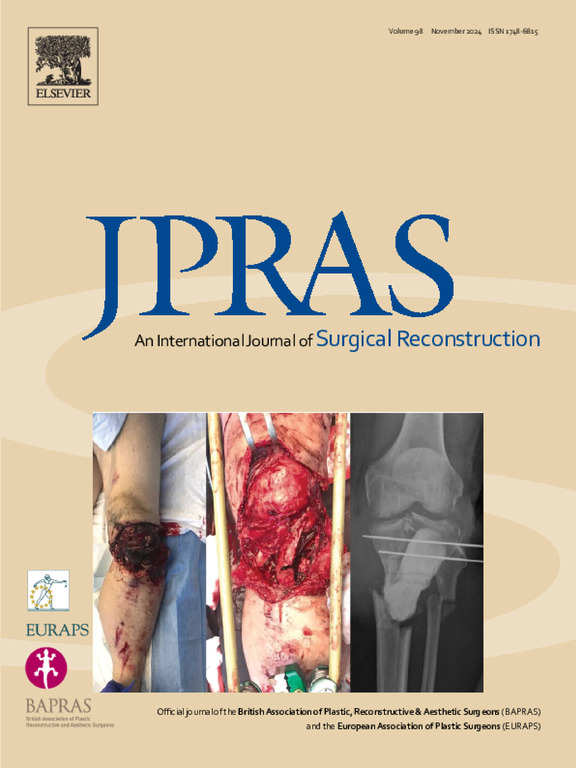Understanding the heterogenicity of unicoronal synostosis – A morphometric analysis of cases compared to controls
IF 2
3区 医学
Q2 SURGERY
Journal of Plastic Reconstructive and Aesthetic Surgery
Pub Date : 2024-09-18
DOI:10.1016/j.bjps.2024.09.044
引用次数: 0
Abstract
Background
Preoperative severity of unicoronal synostosis varies greatly and involves the frontal bone, skull base and orbits. Degree of deformity affects long-term morphological and functional outcomes after surgery. The aim of this study was to describe the morphological heterogenicity and investigate its relation to patient-specific factors.
Materials and methods
In this retrospective cohort study, non-syndromic unicoronal synostosis patients treated between 2006 and 2022 at Necker Hospital, France or Uppsala University Hospital, Sweden, were included and matched to controls. Severity of skull base, orbital and posterior skull asymmetry, degree of anterior plagiocephaly and Harlequin deformity, lateralisation, head circumference, age, timing of metopic fusion and fusion of peri-pterionic sutures were investigated.
Results
Ninety-five patients and ninety-three controls were included. Skull base asymmetry was linearly related to orbital asymmetry (p < 0.001), correlated with earlier CT scans (p = 0.004) and anterior (p < 0.001) and posterior (p = 0.03) plagiocephaly. Posterior plagiocephaly was more common in patients (31%) compared with controls (5%) (p < 0.001). A patent metopic suture above nine months of age was associated with severe Harlequin deformity (p = 0.04) and a lower head circumference when fused (p = 0.03). Fronto-sphenoidal suture fusion was associated with later CT scans (p < 0.001) and less skull base asymmetry (p = 0.002). Spheno-parietal fusion was correlated with decreased skull base asymmetry (p = 0.03). Right lateralisation was more common in females.
Conclusions
Heterogenicity of unicoronal synostosis seems to be predominantly explained by variability in skull base morphology. Peri-pterionic fusions might limit deformity.
了解单冠突触症的异质性--病例与对照组的形态计量分析
背景单冠状突触症的术前严重程度差异很大,涉及额骨、颅底和眼眶。畸形程度会影响术后的长期形态和功能预后。本研究旨在描述形态异质性,并探讨其与患者特异性因素的关系。材料与方法在这项回顾性队列研究中,纳入了2006年至2022年间在法国内克尔医院或瑞典乌普萨拉大学医院接受治疗的非综合征单侧突眼患者,并与对照组进行了配对。研究对象包括颅底、眼眶和后颅骨不对称的严重程度、前颅畸形和哈勒金畸形的程度、侧位、头围、年龄、元骨融合的时间以及颅骨周围缝合的融合情况。颅底不对称与眼眶不对称呈线性关系(p < 0.001),与较早的 CT 扫描(p = 0.004)、前方(p < 0.001)和后方(p = 0.03)颅外畸形相关。与对照组(5%)相比,患者(31%)的后颅畸形更为常见(p < 0.001)。九个月以上的蝶骨缝通畅与严重的哈勒金畸形(p = 0.04)和融合后头围较低有关(p = 0.03)。前额蝶骨缝融合与较晚的 CT 扫描(p < 0.001)和较少的颅底不对称(p = 0.002)有关。椎旁融合与颅底不对称程度降低有关(p = 0.03)。结论单侧突眼的异质性似乎主要是由颅底形态的变异造成的。蝶骨周围融合可能会限制畸形。
本文章由计算机程序翻译,如有差异,请以英文原文为准。
求助全文
约1分钟内获得全文
求助全文
来源期刊
CiteScore
3.10
自引率
11.10%
发文量
578
审稿时长
3.5 months
期刊介绍:
JPRAS An International Journal of Surgical Reconstruction is one of the world''s leading international journals, covering all the reconstructive and aesthetic aspects of plastic surgery.
The journal presents the latest surgical procedures with audit and outcome studies of new and established techniques in plastic surgery including: cleft lip and palate and other heads and neck surgery, hand surgery, lower limb trauma, burns, skin cancer, breast surgery and aesthetic surgery.

 求助内容:
求助内容: 应助结果提醒方式:
应助结果提醒方式:


